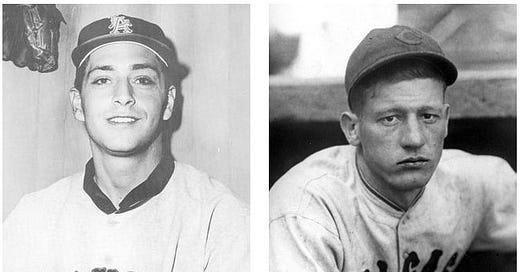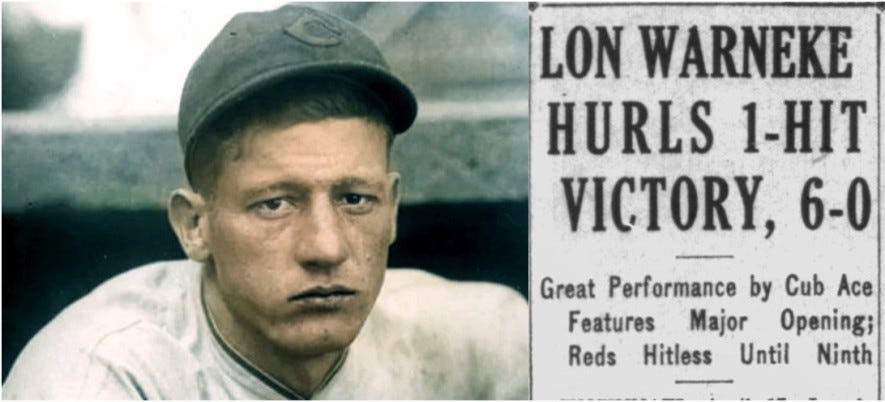Backroads and Ballplayers # 102
Stories of the famous and not-so-famous men and women from a time when baseball was "Arkansas' Game." Backroads and Ballplayers Weekly is always free and short enough to finish in one cup of coffee.
This week’s post was delayed by some unforeseen conflicts. Usually, Backroads and Ballplayers Weekly will arrive on Monday evening.
Thoughts on America’s Pastime, What about the sacrifice bunt, a Hummingbird in April, and Bo’s False Start
I watched Arkansas Tech in a three-game series last week. The three NCAA Division II games had everything baseball fans love about the game and everything detractors dislike about their grandpa’s game.
First, baseball deserves the discarded label “America’s Pastime.” Despite some artificial time limits to make the game palatable to a younger, more impatient audience, baseball is a leisurely, untimed game.
The three college games I watched ambled along for about three hours each. There were 425 ft. homers, eight-run innings, and some of the best defensive plays I have seen at any level.
There is time to watch the “game within a game” between the pitcher and the hitter. Each pitch can be predicted and evaluated. Every change in the ball/strike count changes the game, and the entire process of the action is initiated by the one-on-one confrontation between pitcher and batter. The game within a game is like chess with a ball and bat. It is, as Ken Burns observes, “The only game where the defense has the ball.”
Other topics of conversation at baseball games include the weather, the food choices, and the catcher’s walk-up music. Susan’s popcorn, served in a paper bag the size of a five-pound flour sack, lasted six innings in game three. She says it ranks up there with movie popcorn.
In between bites, she yelled, “Moun Blue,” at least three times, visited with a toddler from Oklahoma, and critiqued the Matlock finale. You can’t do that at a basketball game.
The Art of the Bunt
At least a half-dozen times, the coaches in the series I watched called for a sacrifice bunt. I forgot to count the attempted bunts in the third game, so there were probably more.
I can’t remember a time it was successful, but I may have forgotten an unexpected successful sacrifice. I do remember thinking that these guys can’t bunt. They were not taught to bunt as youngsters; they are sure it costs them a double off the wall to sacrifice, and their heart just isn’t in it.
One particularly disgruntled guy on the visiting team was asked to bunt with two strikes. He lunged at an outside pitch and missed. He and the coach were equally dissatisfied with the whole experience.
By the way, Bill James is against the sacrifice with a few exceptions. I agree, especially if the college guy was the shortstop on his American Legion team and never got the bunt sign in the first 20 years of his life.
Time is running out at Baum-Walker and in your hometown. Go see a college game this weekend. Rediscover America’s Pastime. Take a date. The popcorn is great, and life slows down to a leisurely pace that you may have missed.
This weekend is the last homestand for Arkansas Tech. Admission is free, there are treats from local businesses, and the popcorn is served in a flour sack. Baseball is America’s Pastime. The bunting will be questionable.
Arkansas Tech Bash at the Ballpark 2025
___________________
A Hummingbird in April and Bo’s Magic April (with some May)
“Mr. April” - Lon Warneke
Until expanded schedules and excursions to Japan changed the calendar, April marked the beginning of baseball season. Many players open the season by shaking off the winter rust. A much smaller group opens baseball’s year in mid-season form.
The sum of Arkansas’ Lon Warneke’s Aprils makes a case for his consideration as “Mr. April,” perhaps the best opening-month pitcher in baseball history. The story of the Arkansas Hummingbird’s amazing Aprils is a lead story in Only in Arkansas this week. A Hummingbird in April, Only in Arkansas
Please read and share the Aprils of Lon Warneke and return here to read about a rookie whose first month in the major leagues was the highlight of his career.
____________________
A Subscription sends these weekly posts to your mailbox. There is no charge for the subscription or the Backroads and Ballplayers Weekly.
If you do not wish to subscribe, you will find the weekly posts on Monday evenings at Backroads and Ballplayers on Facebook. SAVE THE LINK…
____________________
Bo’s Magic April (with some May included)
Last week, loyal reader, Rodney Todd, suggested April’s Mystery Photo might be Bo Belinsky. It wasn’t, but it brought back the biggest story in baseball in the spring of my eighth-grade year. Several years before Bo Jackson earned the promotional phrase, “Bo Knows Baseball,” Bo Belinsky made sports page headlines…for a while.
Robert “Bo” Belinsky was born in New York City in 1936, and he had spent five years working his way through the minors when he arrived in Little Rock in 1961. He had won 35 games and lost 35 on his travels through the Baltimore organization, but although his pitching was not attention-getting, his brash, big-city confidence was hard to ignore.
Belinsky’s 1961 season with the Travs added another mediocre year to his resume. He won 9 and lost 10 in Little Rock, but his ERA was a respectable 3.72. On the plus side, Belinsky struck out 182 batters in 174 innings. Maybe his performance in AA deserved a big-league trial, but it was not good enough for Paul Richards, the Orioles’ skipper. Belinsky’s after-hours partying had not impressed Richards.
The Orioles had seen enough, allowing the Los Angeles Angels to choose Bo Belinsky in the Rule 5 draft the winter after his season in Arkansas.
“My only regret is that I can’t sit in the stands and watch myself pitch.” —Bo Belinsky.
The 1962 Angels needed some fan interest and some mound help, and it looked like they had found both in Bo Belinsky. Good-looking and confident, Belinsky thrived on the California lifestyle. He was equally successful on the mound…for about five weeks!
The rookie sensation won his first five decisions. A whirlwind start that included a no-hitter on May 5, matched against Baltimore’s ace Steve Barber. After going 4-1 in May, Belinsky breezed through his first two months in the big leagues with a 6-1 record. It would be the best two months of his career. He finished the season with a 10-11 record in 187 innings pitched. Those marks would be his career highs in all three categories. Incidentally, he led the American League in walks.
Bo Belinsky played two more years with the Angels, followed by two seasons in Philadelphia and a summer with the Astros. He landed back in the minors with the Hawaii Islanders in 1968 and threw another no-hitter. Belinsky was back in the big leagues with the Pittsburgh Pirates in 1969 and the Cincinnati Reds in 1970, the final year of his career.
Although he never became the pitcher falsely previewed by those remarkable five weeks when he was the toast of the city in LA, Bo Belinsky remained a favorite topic for baseball columnists.
Belinsky made as many headlines with women as for his occasional pitching victories. “For both variety and sheer volume of female companions,” opined sportswriter Myron Cope, “Belinsky is an authentic lion of the boudoir.” He dated Ann-Margret, Tina Louise, and Connie Stevens, was briefly engaged to Mamie Van Doren in 1963, and married Jo Collins, Playboy’s 1965 Playmate of the Year, in 1968. “What I’m looking for is one with dough,” said Belinsky as a rookie. “I need a poor one like Custer needed more Indians.”
Gregory Wolf, writing about Belinsky in the SABR BioProject, suggested,
“No pitcher in baseball history ever got more mileage out of 28 wins…as Bo Belinsky.”
Look for a complete story of Bo Belinsky’s baseball adventures in a future Backroads and Ballplayers Weekly.
____________________
More Arkansas baseball history and book ordering information: Link
Welcome, new subscribers. Have you missed some posts? Link







